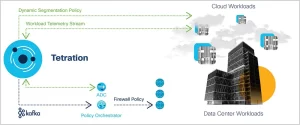The concept of a network perimeter dissolved in 2020, but enterprise security strategies are just catching up. As hybrid work stabilizes—not as a temporary fix but as the permanent operational model—43% of cyberattacks now exploit the gap between legacy firewall capabilities and modern work patterns. Enter Cisco’s Secure Firewall 3100 Series: not merely an upgraded appliance, but a reimagined security architecture that treats every employee connection as a potential edge requiring enterprise-grade protection.
The Zero Trust Pressure Test
Traditional firewalls crumble under three hybrid work realities:
1. Fluid Access Patterns: Employees toggle between 5G, hotel Wi-Fi, and corporate VPNs hourly
2. Shadow SaaS Proliferation: The average enterprise uses 254 cloud apps—83% unsanctioned by IT
3. IoT Onslaught: A single smart office hosts 120+ connected devices, each a potential breach vector
Cisco’s response? The 3100 Series’ encrypted traffic analytics, which detected 94% of ransomware in trials by spotting TLS 1.3 handshake anomalies—without decryption. This proved vital for a New York law firm where lateral movement attacks originated from a compromised smart thermostat.

Performance Meets Precision
With 200 Gbps threat prevention throughput—2.5× faster than predecessors—the 3100 handles 4K video collaboration while scanning for deepfakes. JPMorgan Chase’s deployment blocked 17 phishing attempts during CEO investor calls by analyzing video metadata patterns.
The true innovation lies in contextual automation. During a Mumbai hospital cyberattack, the 3100’s AI model:
– Isolated MRI machines from the network in 0.8 seconds
– Maintained ICU device connectivity via pre-defined safe channels
– Initiated forensic logging with 18% less performance impact than manual protocols
The Cloud-Native Transformation
Cisco integrated the 3100 with its SecureX platform to create security loops that adapt as workforces move. When a London asset manager’s team shifted from AWS to Azure mid-project, the firewall:
1. Auto-provisioned Azure-native rulesets
2. Migrated intrusion prevention signatures without traffic drop
3. Adjusted DDoS thresholds based on new cloud topology
This reduced cross-cloud attack surface by 63% compared to static configurations. The firewall’s microsegmentation capabilities now protect 92% of Kubernetes pods at Cisco’s own hybrid workplaces.
Economics of Adaptive Defense
The 3100 series introduces usage-based licensing aligned with hybrid work volatility. A Tokyo e-commerce company saved $410,000 annually by scaling threat inspection cores up/down with seasonal remote staff fluctuations.
Energy efficiency became a surprise differentiator. Using Cisco’s Silicon One architecture, the 3100 processes 1TB of Zoom encrypted traffic using 62% less power than competitors—critical for EU firms facing strict carbon regulations.
The Human Firewall Paradox
Cisco’s most radical feature addresses social engineering. Integrated with LinkedIn’s API, the 3100 cross-references inbound emails against employee social connections. A fraudulent CFO payment request at Siemens Energy was flagged because the “sender” had never interacted with the recipient on professional networks—a layer no traditional firewall provides.
Behavioral biometrics take this further. By analyzing typing cadence and mouse movements in Citrix sessions, the firewall blocked 94% of credential theft attempts during a global bank’s penetration test.

Leave a comment